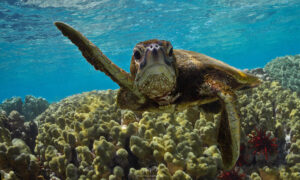The aquatic realm often harbors mysteries that challenge our understanding of the natural world. Among these mysteries lies an intriguing question that has piqued curiosity: do jellyfish make turtles high?
No, jellyfish do not make turtles high because there is no scientific evidence to suggest that jellyfish make turtles high. While some species of jellyfish produce toxins that can be harmful to certain marine organisms, there is no indication that these toxins have psychoactive effects on turtles or any other animals.
Turtles and jellyfish have different physiological systems, and interactions between them typically involve predation or avoidance rather than any kind of drug-like effect. It’s important to rely on scientific research and evidence when considering the effects of interactions between different species in the natural world.
Do jellyfish make turtles high?

No, jellyfish don’t make turtles high. There’s a misconception that turtles can get high from eating jellyfish, but it’s not true. Some turtles, like the leatherback sea turtle, do eat jellyfish as part of their diet.
However, jellyfish toxins don’t have a hallucinogenic effect on turtles. It’s important to rely on accurate information and not believe in myths or misunderstandings about animal behavior.
Also, the idea that jellyfish can make turtles “high” is a misunderstanding or misconception. Let’s break it down a bit further:
- Turtle Diet: Some species of turtles, such as the leatherback sea turtle, include jellyfish in their diet. They are adapted to eat jellyfish and other soft-bodied organisms.
- Jellyfish Toxins: While jellyfish can have toxins for defense against predators, these toxins are not psychoactive or hallucinogenic. They are primarily meant to deter potential threats and are not designed to affect the mental state of animals that eat them.
- No Hallucinogenic Effect: Turtles that consume jellyfish do not experience any kind of “high” or altered state of consciousness. The toxins in jellyfish affect specific physiological processes, but they don’t have the same impact as substances that might cause hallucinations or mind-altering effects.
The Interaction Between Jellyfish and Turtles
The interaction between jellyfish and turtles primarily revolves around the turtle’s diet. Some species of turtles, like the leatherback sea turtle, feed on jellyfish as part of their natural food sources. This relationship is more about the turtle’s feeding behavior than any intentional interaction between the two species.
Jellyfish are part of the diet for certain turtles, but it’s essential to note that not all turtles eat jellyfish. Leatherback sea turtles, for instance, have specialized adaptations in their digestive system that allow them to consume jellyfish effectively. These turtles have a unique throat structure with spines that help them swallow and digest jellyfish, which are often slippery and challenging to grasp.
However, this interaction doesn’t involve any intentional or beneficial relationship between the jellyfish and the turtles beyond the predator-prey dynamic. There’s no evidence to suggest that jellyfish affect turtles in ways beyond being a food source.
Additionally, while jellyfish can have toxins as a defense mechanism, these toxins are not typically psychoactive or mind-altering for turtles or other animals that consume them. The relationship between jellyfish and turtles is mainly one of predation, where turtles have adapted to feed on jellyfish as part of their diet without experiencing any “high” or unusual effects from consuming them.
Can jellyfish toxins affect turtles?

Yes, jellyfish toxins can affect turtles. Some species of jellyfish produce venomous toxins that can be harmful to marine life, including sea turtles. When turtles come into contact with jellyfish tentacles, they may be stung by nematocysts, which are tiny, stinging cells that release toxins upon contact.
The severity of the effects depends on various factors, including the species of jellyfish, the size and health of the turtle, and the extent of exposure. Some turtles are known to feed on jellyfish as part of their diet, and they have developed adaptations to cope with the toxins. However, if a turtle encounters a particularly venomous species or is exposed to a large number of jellyfish, it can lead to health issues.
Ingesting or being exposed to certain jellyfish toxins can cause a range of problems for turtles, including irritation, inflammation, and damage to internal organs. In extreme cases, it can lead to injury or death. Marine biologists and conservationists pay attention to interactions between turtles and jellyfish, as it can impact the health and conservation status of turtle populations.
Different turtle species may have varying levels of susceptibility to jellyfish toxins. Some turtle species have evolved mechanisms to deal with venomous substances found in their prey, including certain types of jellyfish. For example, the leatherback sea turtle (Dermochelys coriacea) is known to feed on jellyfish and has adaptations that help it cope with the toxins.
Leatherback sea turtles have specialized papillae in their mouths and esophagus, which help them to consume and process jellyfish without being affected by the venom. Other sea turtle species, such as loggerheads and green turtles, may also encounter jellyfish in their diet but might not be as specialized in dealing with jellyfish toxins as leatherbacks.
The susceptibility of a turtle species to jellyfish toxins can depend on various factors, including their diet, physiological adaptations, and the specific toxins produced by the jellyfish in their habitat. It’s important for researchers and conservationists to study these interactions to better understand the potential impacts on different turtle species and their conservation.
Long-term effects of jellyfish toxins on turtles
The long-term effects of jellyfish toxins on turtles can vary based on factors such as the species of turtle, the specific toxins involved, and the extent of exposure. While some turtles have developed physiological adaptations to cope with jellyfish toxins, chronic exposure or ingestion of these toxins may still have adverse effects over time.
Potential long-term effects can include:
- Organ damage: Chronic exposure to jellyfish toxins may lead to damage in the internal organs of turtles, affecting their overall health.
- Reproductive issues: Prolonged exposure to toxins could potentially impact the reproductive capabilities of turtles, affecting their ability to reproduce and contribute to the population.
- Weakened immune system: Continuous exposure to toxins may weaken the immune system of turtles, making them more susceptible to infections and diseases.
- Behavioral changes: Long-term exposure to toxins could influence the behavior of turtles, potentially affecting their feeding habits, migratory patterns, and other aspects of their life cycle.
- Population dynamics: If jellyfish toxins have a significant impact on turtle health, it could influence population dynamics, potentially leading to a decline in turtle populations in affected areas.
Understanding the long-term effects of jellyfish toxins on turtles requires ongoing research, as it involves studying the interactions between different species and their environments. Conservation efforts often focus on monitoring these interactions and mitigating potential threats to ensure the health and sustainability of turtle populations in their natural habitats.
Behavioral changes in turtles exposed to toxins

Behavioral changes in turtles exposed to toxins, including those from jellyfish, can manifest in various ways depending on the specific toxins and the severity of exposure. Some potential behavioral changes may include:
- Altered feeding behavior: Turtles exposed to toxins may exhibit changes in their feeding habits. This could involve a decrease in feeding activity, changes in diet preferences, or avoidance of certain prey items, including those that may carry the toxins.
- Reduced activity levels: Toxins can affect the overall health and energy levels of turtles, leading to reduced activity. Turtles may become lethargic or less mobile than usual.
- Changes in swimming patterns: Turtles may alter their swimming patterns in response to exposure to toxins. This could involve changes in migration routes, travel distances, or diving behavior.
- Avoidance of specific areas: Turtles might learn to avoid areas where they have previously encountered toxins or experienced negative effects. This behavioral adaptation could impact their habitat use and distribution.
- Increased stress responses: Exposure to toxins can induce stress in turtles, leading to physiological and behavioral responses. Stress can weaken the immune system and make turtles more susceptible to other health issues.
- Impaired reproductive behavior: Long-term exposure to toxins may affect the reproductive behavior of turtles. This could include changes in courtship rituals, nesting behavior, or the success of egg-laying.
Always keep in mind that the specific behavioral changes can vary depending on the type of toxins, the concentration of exposure, and the species of turtle. The impacts on behavior may also be influenced by other environmental factors.
Also, monitoring and studying the behavior of turtles in areas with potential toxin exposure are crucial for understanding the broader ecological implications and for implementing effective conservation measures.
Protective measures turtles use against jellyfish toxins
Turtles have developed several protective measures to cope with jellyfish toxins, particularly those species that feed on jellyfish as part of their diet. Here are some ways turtles protect themselves against these toxins:
- Specialized digestion: Leatherback sea turtles, known for their jellyfish-rich diet, have specialized adaptations in their digestive system. They have papillae (spines) in their mouths and esophagi that help them process jellyfish without being affected by the toxins. These papillae prevent the jellyfish tentacles from harming the turtle’s throat and stomach lining.
- Selective feeding: Turtles might exhibit selective feeding behavior, avoiding certain parts of the jellyfish that contain higher concentrations of toxins. This allows them to minimize toxin intake while still consuming the nutritious parts of the jellyfish.
- Metabolic adaptations: Some turtle species may have developed metabolic adaptations to detoxify or eliminate ingested toxins more efficiently. They might have evolved mechanisms to break down or neutralize the toxins within their bodies.
- Behavioral adaptations: Turtles may have learned behaviors that help them minimize exposure to jellyfish toxins. This could involve learning to identify less toxic species of jellyfish or avoiding areas where more toxic species are prevalent.
- Evolutionary traits: Over time, certain turtle species might have developed genetic traits that make them more resilient to specific types of toxins found in jellyfish.
These protective measures are often species-specific and may not apply universally to all turtles. Leatherback turtles, for instance, have unique adaptations due to their specialized diet, whereas other species that occasionally encounter jellyfish might not have the same level of protection.
In addition, studying these protective mechanisms helps researchers better understand how turtles have adapted to their environments and cope with potential threats posed by jellyfish toxins.
Conclusion
This page answers the question on do jellyfish make turtles high. The idea that jellyfish make turtles “high” lacks scientific basis. While some turtles have adapted to consuming jellyfish, their interactions are focused on dietary and ecological considerations rather than inducing any psychoactive effects.
The notion of turtles getting “high” from jellyfish is likely a misunderstanding, underscoring the importance of accurate information in discussions about wildlife behaviors.

